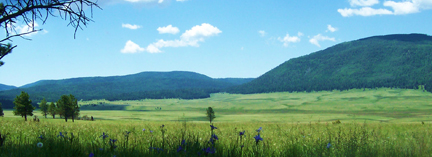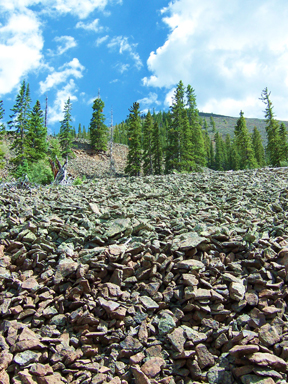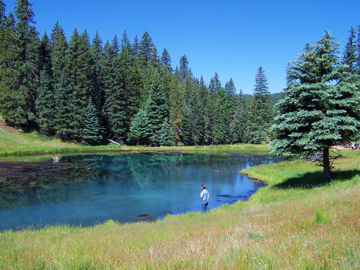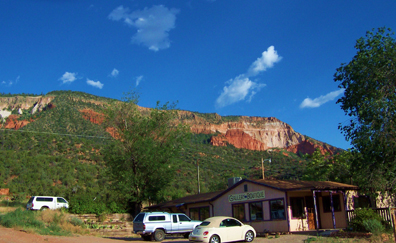|
Travels in Geology July 2007 posted July 24, 2007
A Secret Garden: New Mexico’s Valles Caldera
 Jenna Beck |
| The Valles Caldera National Preserve in New Mexico is the remnants of a million-year-old eruption. Today, it is open for hiking and geologic, biologic and archaeologic tours. |
Spending a day in the quiet expanse of the Valles Caldera National Preserve is worth the effort of booking reservations and getting to this remote location. Hidden beyond Los Alamos in the New Mexico Jemez Mountain Range, the 360-square-kilometer (89,000-acre) preserve is a secret garden enclosed by a geologic wonder, just two and a half hours from the Albuquerque airport. From Albuquerque, the highway winds through pueblos and red rock canyons before it reaches Jemez Springs and the preserve.
The Valles Caldera is one of three active calderas in the United States. It encircles a field of volcanoes whose resurgent domes partition the 22-kilometer-wide caldera into five sections, or valles, which means valleys without trees in Spanish. The largest of these, Valle Grande, is almost 10 kilometers long and six kilometers wide. A magma chamber seethes five kilometers below the idyllic grasslands that shroud the surface of the Valle Grande. The eruptions formed the caldera roughly 1.2 million years ago, when the volcanic field expelled more than 750 cubic kilometers of ash and lava. Ash deposits contributed tuft to the surrounding Jemez Mountains, and the landscape sank back in on itself to form the vast bowl of the Valles Caldera.
 Jenna Beck |
| Valles Caldera is one of three active calderas in the United States. The "felsenmeer" pictured above was formed when water froze in the cracks of the volcanic tuft, shattering the rock into chaotic pieces. |
Though a million years ago the caldera was a vast moonscape of ash, today the valles are filled with grassy meadows cut by meandering streams, which are home to prairie dogs, fish and roaming herds of elk and cattle. The resurgent domes are forested with conifers and aspen; some of the trees bear initials that sheepherders carved in the 1920s, others the claw marks of black bears.
The abundance of elk, obsidian flakes and wild irises offer proof that the preserve gets little human traffic. Before the federal government acquired the caldera in 2000, it had been in the hands of a ranching family for 140 years. Now that the land is public, the board of trustees that manages the preserve limits the number of visitors in order to protect the integrity of the landscape and “emphasize quality of experience over quantity of experiences,” as written in their management principles.
The vast hollow of the Valle Grande and the exquisitely formed caldera rim can be seen from Highway 4, which passes through Bandelier National Monument on one side of the valle and Jemez Springs on the other. There are a few pullouts for awestruck motorists, complete with signs that explain the geologic history of the stunning landscape. For visitors who don’t have time for a tour, the pullouts do offer great photo opportunities.
Those who wish to see the interior of the Valles Caldera preserve, or to see any of the smaller valles, might want to book a spot on one of the guided excursions, which range from group hikes to geology or archaeology tours to elk hunts or fishing clinics. If you do have the time, the geology tours are frequent and inexpensive, and worth it. The preserve geologist leads walking tours through the caldera at 10 a.m. and noon every Friday, Saturday and Sunday. In an effort to make the caldera more accessible, the preserve does not require reservations for the geology tours — you just show up ahead of time and pay a modest $5 fee.
 Jenna Beck |
| The caldera is its own self-contained watershed, home to springs, streams and mineral bogs (as pictured here). |
If you want to get deeper into the preserve, a hiking tour is your best bet. Most of the hiking trails are about 11 kilometers long, pass over the forested resurgent domes and offer spectacular views of the grassy meadows below. You can only hike from June through September, and hikers are advised to bring extra clothing for the elevation change. The hikes take 4 to 5 hours to complete, plus 30- to 60-minute van rides to and from the trailheads. There are guided and unguided tours, both of which require reservations and a $10 to $15 fee.
The cliff dwellings preserved at Bandelier National Monument are adjacent to the Valles Caldera, and make a pleasant side trip. Ancestral Pueblo people carved caves into the soft volcanic tuft roughly 600 years ago that can now be seen from a short, 2-kilometer trail loop. You can get a good sense of the archaeological ruins in a couple of hours, but it might be worth spending a little more time and visiting the backcountry sites as well as the visitor center, where cultural demonstrations are offered on summer weekends. These include lessons in making pottery and traditional drums, in baking bread and in traditional dances. Seventy percent of the park is designated as a wilderness area, and the backcountry areas contain other ruins and hiking trails of various lengths and destinations. Backpackers must obtain permits to camp overnight in Bandelier.
 Jenna Beck |
| The small towns around the caldera offer spas, golfing, art boutiques and quaint restaurants, all in the shadow of red rock mesas. |
For those who prefer to sleep in beds, the town of Jemez Springs has several quaint hotels and is a delightful place to spend an evening. Jemez Springs is on Highway 4, about half an hour west of the main gate of the Valles Caldera. The town rests at the feet of red rock mesas, the eroded remnants of lava flows from the caldera’s volcanic field. It is also the best place to enjoy the most inviting features of the volcanic landscape — the hot springs. The Jemez Springs Bath House in the middle of town offers indoor tubs and spa-like amenities such as massages and body wraps. Giggling Springs is a privately owned outdoor pool, and the local Zen center allows anyone to use its springs when workshops are not in session. All three are walking distance from the local hotels, and are a good choice for bathers who would rather not hike or drive after a full day in the caldera. For those who like to work for their bath, there are several hot springs on U.S. Forest Service land within driving distance of Jemez Springs. Directions and GPS coordinates are available on the Jemez Springs Web site.
After your foray into the wilds of the caldera and hot springs, head into Los Alamos, which is about half an hour east of the caldera’s main gate and offers some great golf, as well as local art and cuisine. As Los Alamos was the birthplace of the first atomic weapon and is now home to the Los Alamos National Laboratory research community, nuclear history buffs may want to check out the Bradbury Science Museum, which is a good place to learn about the Manhattan Project and the current research pursuits at Los Alamos (they are many and varied).
If you’re traveling through the Desert Southwest, it’s worth a quick jaunt off the main highway into the Valles Caldera, even if only to see it from the road.
Links:
Valles Caldera National Reserve
Valles Caldera Coalition
Bandelier National Monument
Jemez Springs tourist information
Los Alamos tourist information
Los Alamos National Laboratory
Back to top

 Subscribe
Subscribe


